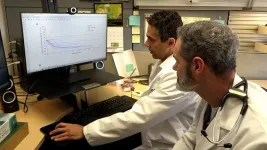(Press-News.org) Updating pulse oximeters
A portable device used to detect blood oxygen levels revolutionized the medical field 50 years ago and is now receiving essential updates
Efforts to improve the accuracy of pulse oximetry readings for diverse groups of patients and in multiple settings are underway. Joel Moss, M.D., Ph.D., a senior investigator in NHLBI’s Laboratory of Translational Research, and Bennett Yang, a postbaccalaureate fellow in Dr. Moss’s lab, describe this process and the future of pulse oximetry research.
Q: Why are portable pulse oximeters important?
Bennett Yang: The cells that make up the human body depend on oxygen for survival. Within minutes of oxygen desaturation, tissue starts to die. So, the importance of monitoring a patient’s blood oxygen levels, especially if they are low, such as during surgery or if a person has COVID-19 or pneumonia, cannot be understated. The pulse oximeter, or pulse ox, was created to rapidly and noninvasively estimate a patient’s blood oxygen saturation so that patients and physicians can monitor and adjust for an individual’s oxygen needs.
The portability of the pulse ox, such as those that can clip on fingertips, has made it more accessible and valuable, both within the hospital and at home. The pulse ox works by emitting red and near infrared light from one surface of the finger to a detector on the other side. Oxygenated and deoxygenated blood absorb these lights differently, which allows the pulse ox to calculate oxygen saturation based on these ratios.
Q: What limitations have researchers found with pulse oximeters?
Yang: The pulse ox has revolutionized medicine, but, like any device, it has limitations. For example, pulse ox accuracy tends to decrease as oxygen saturation levels drop, which could lead to inaccurate readings. This, unfortunately, is when oxygen detection is critical.
Additionally, the pulse ox does not perform well if a patient has poor blood flow in their fingertips or if they are wearing nail polish. Blood loss, constricted blood vessels, and conditions, ranging from heart failure to Raynaud’s disease, a rare condition that disrupts blood flow, can all contribute to decreased accuracy.
Physical motion can also disturb pulse ox readings. This is called motion artifact. This is especially a problem for patients who have normal oxygen saturation levels at rest but desaturate when they start to move or during daily activities.
Finally, and critically important, the pulse ox tends to overestimate oxygen saturation in patients with darker skin tones. The reason lies in melanin, which is the skin pigment. Melanin’s job is primarily to block ultraviolet light to protect tissues from underlying damage. And it does this well. But, it also absorbs across a range of wavelengths, including red and near infrared, which are the lights emitted from the pulse oximeter. It tends to do this with differing intensities. The overall effect of this is that it skews measurements upwards in patients with darker skin tones.
Q: What did the COVID-19 pandemic reveal about health disparities related to inaccurate pulse oximetry readings?
Yang: The pitfalls of the pulse ox are not new ideas to the clinic, but the pandemic has raised more concerns about the device’s accuracy. Data from the last three years has made it painfully clear that communities of color as well as socioeconomically disadvantaged populations have disproportionately suffered from COVID. This includes more frequent oxygen desaturation.
Remember, the pulse oximeter tends to overestimate true saturation for these patients. So, not only would these patients require medical intervention more often, but recent research has shown they have also been victim to systemic delays in receiving interventions because the pulse ox is essentially telling physicians that these patients are doing better than they actually are. Hence, health disparities are compounded by the pulse ox’s inaccuracies.
Q: How are researchers studying ways to update this technology?
Yang: Updating the pulse ox will help physicians make the best choices for their patients. Thankfully, several projects are underway. One includes a new green-light pulse ox, which is being studied by researchers in Texas.
Their device is based on the principle that the difference in absorbance between oxygenated and deoxygenated blood is largest in the green-light range. Also, green light does not penetrate through the finger as well as red and near infrared light. The pulse ox instead measures reflection off of the skin rather than being transmitted through it. A benefit is that the light does not have to pass through two layers of skin and two layers of melanin, which also helps avoid any deeper sources of tissue error.
The researchers also calibrated their device using a skin pigment color scale. Therefore, the pulse ox could adjust for the skin color of each patient being monitored.
Q: How is NHLBI’s small business innovation research program supporting translational aspects of this research?
Dr. Moss: The NHLBI small business and innovation research (SBIR) program was established to fund businesses developing devices and technologies that align with NHLBI goals. Specifically, our SBIR topic 114 is part of an effort to support a company in developing a wireless, user-friendly, pulse ox that can interface with mobile devices.
The idea is that patients who need to continuously monitor their oxygen saturation, such as patients with lung disease, should be able to do so during daily activities and with technology that can automatically record their data. The SBIR explicitly mentions the need to recruit a diverse population for clinical study, which will strengthen the pulse ox’s accuracy.
We hope to have two companies compete for a phase 1 award, perhaps with clinical testing, within the next 3-4 years. A developed prototype from one company would advance to a phase 2 clinical trial leading to FDA approval.
Again, the objective is to have a wireless pulse oximeter that measures oxygen levels during exercise, regardless of skin color, and interfaces with mobile devices.
Resources:
To learn more about pulse oximetry research, read Dr. Moss and Bennett Yang’s commentary, entitled “Evolution of the Pulse Ox,” in CHEST.
END
Updating pulse oximeters
A portable device used to detect blood oxygen levels revolutionized the medical field 50 years ago and is now receiving essential updates
2023-07-07
ELSE PRESS RELEASES FROM THIS DATE:
July issues of American Psychiatric Association journals cover advances in social determinants of mental health, youth mental health screening, AI in psychotherapy and more
2023-07-07
The latest issues of three of the American Psychiatric Association’s journals, The American Journal of Psychiatry, Psychiatric Services and The American Journal of Psychotherapy are now available online.
The July issue of The American Journal of Psychiatry features articles on social determinants of health relevant to racial and ethnic disparities as well as postmortem molecular studies. Highlights include:
Recent Advances on Social Determinants of Mental Health: Looking Fast Forward.
Differences in Social Determinants of Health Underlie Racial/Ethnic Disparities in Psychological Health and Well-Being: Study of 11,143 Older Adults.
The Nature ...
Breakthrough identifies new state of topological quantum matter
2023-07-07
ITHACA, N.Y. -- Cornell scientists have revealed a new phase of matter in candidate topological superconductors that could have significant consequences for condensed matter physics and for the field of quantum computing and spintronics.
Researchers at the Macroscopic Quantum Matter Group at Cornell have discovered and visualized a crystalline yet superconducting state in a new and unusual superconductor, Uranium Ditelluride (UTe2), using one of the world’s most powerful millikelvin Scanned Josephson Tunnelling Microscopes (SJTM). This “spin-triplet electron-pair crystal” is a previously unknown state of topological quantum matter.
The findings, ...
Fecal transplants show promise in improving melanoma treatment
2023-07-07
LONDON, ON – In a world-first clinical trial published in the journal Nature Medicine, a multi-centre study from Lawson Health Research Institute, the Centre hospitalier de l’Université de Montréal (CHUM) and the Jewish General Hospital (JGH) has found fecal microbiota transplants (FMT) from healthy donors are safe and show promise in improving response to immunotherapy in patients with advanced melanoma.
Immunotherapy drugs stimulate a person’s immune system to attack and destroy cancer. While they can significantly improve survival outcomes in those with melanoma, they are only ...
Privacy-preserving collaborative data collection and analysis with many missing values
2023-07-07
To control pandemics like the novel coronavirus infection (COVID-19), data such as the age, gender, family composition, and medical history of infected individuals are required. While patients themselves may provide this information to medical institutions, these details are highly confidential. If the data is properly handled for privacy protection, it can be shared with researchers worldwide without identifying the infected individual, which can help clarify the state of the pandemic and more accurately predict its progression.
There ...
Hexagonal MBene: A promising platform for the electrocatalytic nitrogen reduction reaction
2023-07-07
They published their work on July. 6 in Energy Material Advances.
"In 2017, we reported a new family of 2D transition metal borides as analogues to MXenes and coined a catchy name for them, MBenes," said paper author Zhimei Sun, professor of the School of Materials Science and Engineering at Beihang University. "Up till now, MBenes have been widely studied as catalysts or substrates of various reactions, including HER, ORR/OER, NRR and CO2RR. Notably, the exploration of electrocatalytic performance for MBenes mainly focuses on those with orthorhombic structures, while there are few studies on applying ...
AI tool decodes brain cancer’s genome during surgery
2023-07-07
Scientists have designed an AI tool that can rapidly decode a brain tumor’s DNA to determine its molecular identity during surgery — critical information that under the current approach can take a few days and up to a few weeks.
Knowing a tumor’s molecular type enables neurosurgeons to make decisions such as how much brain tissue to remove and whether to place tumor-killing drugs directly into the brain — while the patient is still on the operating table.
A report ...
Spider mite males undress maturing females to win the first mating
2023-07-07
In males of many species, it pays to identify females that are nearing maturity to be the first in line for mating. Now researchers reporting in the journal iScience on July 7 have found a remarkable example: male spider mites guard and then actively strip off the skin of premature females that are soon to molt and mature to make them accessible for mating sooner.
“Our study documents an exceptional male behavior in the animal kingdom, namely that male spider mites strip off the skin of premature females that are close to molting into adulthood,” said Peter Schausberger ...
Trends in opioid toxicity–related deaths in the US before, after the start of the pandemic
2023-07-07
About The Study: Deaths due to opioid toxicity increased substantially during the COVID-19 pandemic. By 2021, 1 of every 22 deaths in the U.S. was attributable to unintentional opioid toxicity, underscoring the urgent need to support people at risk of substance-related harm, particularly men, younger adults, and adolescents.
Authors: Tara Gomes, Ph.D., of the University of Toronto, is the corresponding author.
To access the embargoed study: Visit our For The Media website at this link https://media.jamanetwork.com/
(doi:10.1001/jamanetworkopen.2023.22303)
Editor’s Note: Please see the ...
Evaluation of population-level tobacco control interventions and health outcomes
2023-07-07
About The Study: In this systematic review and meta-analysis, smoke-free legislation was associated with significant reductions in morbidity and mortality related to cardiovascular disease, respiratory system disease, and perinatal outcomes. These findings support the need to accelerate the implementation of smoke-free laws to protect populations against smoking-related harm.
Authors: Ryota Nakamura, Ph.D., of Hitotsubashi University in Tokyo, is the corresponding author.
To access the embargoed study: Visit our For The Media ...
High-resolution map of the human placenta reveals COVID virus hideouts
2023-07-07
Until now, scientific evidence has been inconclusive regarding the ability of SARS-CoV-2, the virus that causes COVID, to replicate in the human placenta. Answering this question, as well as understanding the response of the placenta to other viral infections during pregnancy, is crucial for the development of effective preventive and therapeutic strategies for both the mother and the baby.
At Baylor College of Medicine and Texas Children’s Hospital, researchers have taken a novel approach to shed light on ...
LAST 30 PRESS RELEASES:
Ticking time bomb: Some farmers report as many as 70 tick encounters over a 6-month period
Turning garden and crop waste into plastics
Scientists discover ‘platypus galaxies’ in the early universe
Seeing thyroid cancer in a new light: when AI meets label-free imaging in the operating room
Neutrophil-to-lymphocyte ratio may aid risk stratification in depressive disorder
2026 Seismological Society of America Annual Meeting
AI-powered ECG analysis offers promising path for early detection of chronic obstructive pulmonary disease, says Mount Sinai researchers
GIMM uncovers flaws in lab-grown heart cells and paves the way for improved treatments
Cracking the evolutionary code of sleep
Medications could help the aging brain cope with surgery, memory impairment
Back pain linked to worse sleep years later in men over 65, according to study
CDC urges ‘shared decision-making’ on some childhood vaccines; many unclear about what that means
New research finds that an ‘equal treatment’ approach to economic opportunity advertising can backfire
Researchers create shape-shifting, self-navigating microparticles
Science army mobilizes to map US soil microbiome
Researchers develop new tools to turn grain crops into biosensors
Do supervised consumption sites bring increased crime? Study suggests that’s a myth
New mass spec innovation could transform research
Maternal nativity, race, and ethnicity and infant mortality in the US
Migration-related trauma among asylum seekers exposed to the migrant protection protocols
Jupiter’s moon Europa has a seafloor that may be quiet and lifeless
SwRI upgrades nuclear magnetic resonance laboratory for pharmaceutical R&D
House sparrows in northern Norway can help us save other endangered animals
Crohn's & Colitis Foundation survey reveals more than 1/3 of young adults with IBD face step therapy insurance barriers
Tethered UAV autonomous knotting on environmental structures for transport
Decentralized social media platforms unlock authentic consumer feedback
American Pediatric Society announces Vanderbilt University School of Medicine as host institution for APS Howland Visiting Professor Program
Scientists discover first method to safely back up quantum information
A role for orange pigments in birds and human redheads
Pathways to net-zero greenhouse gas emissions for Southeast Asia
[Press-News.org] Updating pulse oximetersA portable device used to detect blood oxygen levels revolutionized the medical field 50 years ago and is now receiving essential updates


